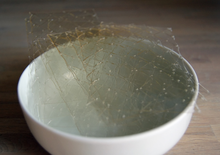
Back جيلاتين Arabic Xelatina AST Jelatin Azerbaijani Жэлацін Byelorussian Желатин Bulgarian জেলাটিন Bengali/Bangla Želatin BS Gelatina Catalan Želatina Czech Желатин CV

Gelatin or gelatine (from Latin gelatus 'stiff, frozen') is a translucent, colorless, flavorless food ingredient, commonly derived from collagen taken from animal body parts. It is brittle when dry and rubbery when moist. It may also be referred to as hydrolyzed collagen, collagen hydrolysate, gelatine hydrolysate, hydrolyzed gelatine, and collagen peptides after it has undergone hydrolysis. It is commonly used as a gelling agent in food, beverages, medications, drug or vitamin capsules, photographic films, papers, and cosmetics.
Substances containing gelatin or functioning in a similar way are called gelatinous substances. Gelatin is an irreversibly hydrolyzed form of collagen, wherein the hydrolysis reduces protein fibrils into smaller peptides; depending on the physical and chemical methods of denaturation, the molecular weight of the peptides falls within a broad range. Gelatin is present in gelatin desserts, most gummy candy and marshmallows, ice creams, dips, and yogurts.[1] Gelatin for cooking comes as powder, granules, and sheets. Instant types can be added to the food as they are; others must soak in water beforehand.